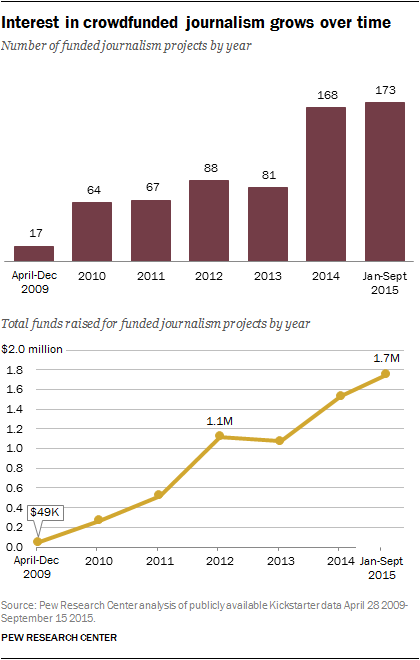
Over the past several years, crowdfunding via the internet has become a popular way to engage public support – and financial backing – for all kinds of projects, from the Coolest Cooler to a virtual reality gaming headset to a prototype of a sailing spacecraft and a bailout fund for Greece. The area of journalism is no exception.
From April 28, 2009 to September 15, 2015, 658 journalism-related projects proposed on Kickstarter, one of the largest single hubs for crowdfunding journalism, received full – or more than full – funding, to the tune of nearly $6.3 million.1
These totals – both in terms of number of projects and funds raised – trail nearly all of Kickstarter’s other funding categories, from music, theater and film to technology and games. Nevertheless, the number of funded journalism projects has seen an ongoing increase over time and includes a growing number of proposals from established media organizations.
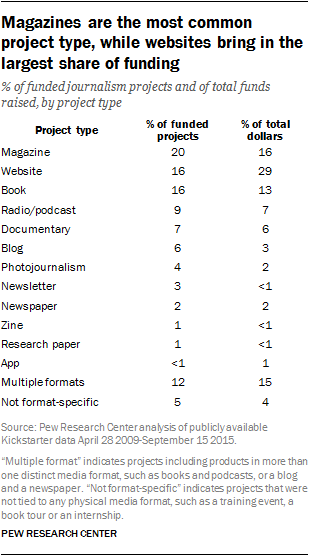
From Kickstarter’s April 2009 launch through the end of the year, 17 journalism projects received funding. That number more than tripled just a year later, to 64 projects in 2010. Growth continued, reaching 168 funded projects in 2014 and 173 in the first nine months of 2015.2
The amount of money put into these projects grew as well, from $49,256 in 2009 and $263,352 in 2010 to $1,743,668 in the first nine months of 2015.
Equally striking is the upward trend in the number of people contributing financially to these journalism projects – rising from 792 in 2009 to 25,651 in 2015.
The majority of funded projects over the seven-year time period,3 71%, were produced by individuals not tied to any journalistic organization – either alone (43%) or as a part of a small group (29%). Established media organizations such as ProPublica and the Boston Review accounted for 22%, while other types of institutions such as public schools and private universities made up the remaining 7%. And while Kickstarter allows project submissions from 18 different countries, fully 84% asked for pledges in U.S. currency. Most (64%) were to be conducted in the U.S., while 36% proposed overseas work which cut across more than 60 countries.
With a median of 54 backers each, the funded projects over these six and a half years varied dramatically in focus, but many were for longer, more comprehensive works in the form of books, magazine articles and documentaries. Together these types of projects accounted for 43% of the funded projects and 36% of the total dollars raised.
Overall, the journalism projects produced and revenue gained from these crowdfunded ventures is still a drop in the bucket compared with the original reporting output that occurs on any given day and the roughly $20 billion in revenue generated by newspaper ads alone. Kickstarter-fueled support for journalism also trails two funding sources that have attracted a fair amount of attention in the journalism world in recent years – philanthropy and venture capital, which Pew Research Center estimated to be in the hundreds of millions in 2013 alone. And the number of journalism-related projects funded over the seven-year period represents a small sliver of total crowdfunding activity on Kickstarter – both in terms of money raised and number of projects. The just over 650 projects funded over the seven-year period trail every other category, sometimes by a great deal. They are, for example, a far cry from the more than 18,000 film and video projects, more than 6,000 gaming projects and nearly 8,000 art projects. Journalism also trails all project categories but one in money raised, again often by wide margins.
Nevertheless, the growing activity here is about more than just dollars and cents or prizewinning reporting. In today’s evolving digital era, it represents a new, niche segment of nontraditional journalism driven in large part by public interest and motivation. It is bringing voice and visibility to efforts that would likely otherwise go unnoticed or unfunded, adding yet another way for the public to engage in creating, funding and disseminating journalism and adding one more option to the arsenal of revenue sources that the industry is desperately seeking to build up.
Kickstarter, recently reincorporated as a public benefit corporation, is one of two larger-scale and broad-based crowdfunding platforms, but it is currently the only major one with a distinct offering for journalism projects. The other, Indiegogo, launched in 2008, offers categories for film, photography, transmedia and video/Web projects – but does not have a specific journalism genre. Another effort, Beacon, was launched in 2013 as a platform dedicated to crowdfunding journalism based on a subscription model but now focuses more on partnerships and matching funds. Several other narrowly targeted crowdfunding platforms dedicated to journalism entered – and left – the space within the past few years, including Spot.us for community-funded journalism, Contributoria and Indie Voices for independent media, Emphas.is for photojournalism and Vourno for video journalism. An analysis of Kickstarter, then, while not completely exhaustive of all possible journalism-related crowdfunding, seemed an appropriate way to gauge the status and dynamics of this emerging arena.
For this project, researchers analyzed publicly available data for the 2,975 proposed projects in Kickstarter’s Journalism category between April 28 2009 and September 15 2015, with an in-depth examination of the 658 journalism projects that received full – or more than full – funding.4 The 658 funded projects were manually coded for a number of specific elements not in the publicly available data, including who proposed them, what specific types of journalistic endeavors were being presented to potential backers, the geographical orientation and whether a project was a new initiative or an expansion of ongoing work.
It is useful to keep in mind that Kickstarter categories can be somewhat fluid and overlap with other topic areas. For example, there are separate categories for publishing, photography, and film and video that could also include elements of reportage. For the purposes of this analysis, we worked with the publicly available data in the assigned Journalism category, and all coding was based on the descriptions and details of the projects provided in the submission.
Media organizations get crowdfunding, but individuals produce largest share of funded journalism projects
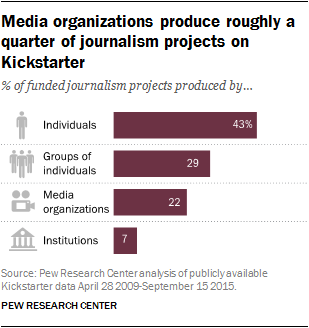
Pew Research Center identified four types of individuals or organizations behind the crowdfunded journalism projects: single individuals, small groups of unaffiliated individuals, media outlets or organizations, and public or private institutions such as universities.
Single individuals accounted for more funded submissions than any other group – 43% over the seven-year time frame. These projects ranged from The Smokey Generation, a digital oral history of wildland firefighters, to a paleontology fieldwork memoir by a freelance science writer, multimedia reporting from Tanzania on the fate of the Kihansi spray toad, and a traveling puppet named Stevie P. offering to write postcards from Europe.
Individuals: Single individuals with no stated formal affiliation and acting on their own behalf
Groups of individuals: Two or more individuals with no formal affiliation and acting on their own behalf
Media organizations: Any outlet or organization whose primary mission is to produce news or information
Institutions: Any kind of public or private institution other than media-focused ones. Includes schools at any level, nonprofits and for-profit businesses
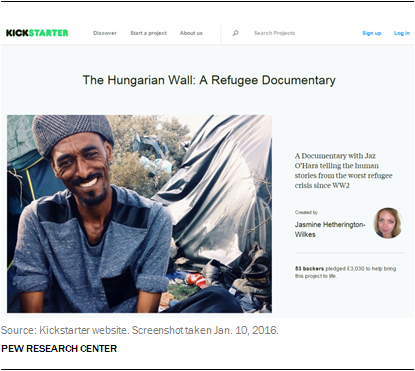
Small groups of individuals accounted for another 29%, including three graduate students of religion who came together to independently produce a podcast, a book by two women about the first western-style theme park in the U.S., and two documentary filmmakers who traveled to Eastern Europe to tell the stories of refugees at the Serbian-Hungarian border.
The individuals involved varied from students of Thai kickboxing to a team of former NPR reporters, which speaks to the broad appeal and significance of crowdfunding to individuals at all points along the journalistic spectrum.
Media organizations have stepped into the crowdfunding space as well, with a certain measure of success. Roughly a quarter of funded journalism projects during this time (22%) were produced by some type of established media outlet or organization.
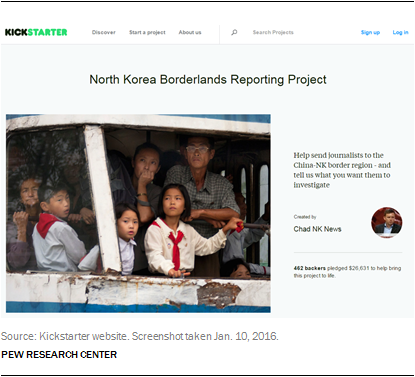
As with individuals and small groups, the media organizations producing projects – as well as the types of projects they proposed – ran the gamut. For example, the San Francisco Public Press, in operation since 2009, sought funding to further connect neighborhoods to their local investigative newspaper by delivering print issues via bicycle; the relatively high-profile Texas Tribune generated funding to livestream a year of 2014 election coverage; and Baltimore Brew successfully sought monetary support to expand its city coverage. Civil Eats’ proposal was to move from an all-volunteer enterprise to one that was able to pay their writers and editors a wage, while NK News looked for backers to fund sending two journalists for an extended time to China-North Korea border region. And the online community ADHDKidsRock.com needed some financial support to keep the website going and add new resources.
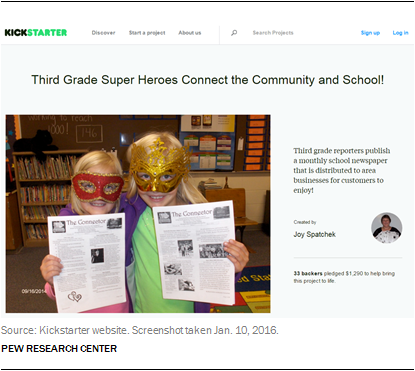
Public and private institutions accounted for 7% of all the journalism proposals. Schools (ranging from elementary schools to high schools to universities) were by far the most common type of institution (31 of 46 of the institutionally based projects) and sought funding for such projects as a summer edition of a student newspaper, a print issue of a campus lifestyle magazine and an online storytelling platform. There were also several projects initiated by 501(c)(3) nonprofits such as Reef Check California, a group that collects data on marine life; the Society for Science and the Public, which sought funding for a Teacher Guide companion to its Science News magazine and a Norwegian think tank which proposed a book focused on an examination of the environment for entrepreneurs in several European countries.
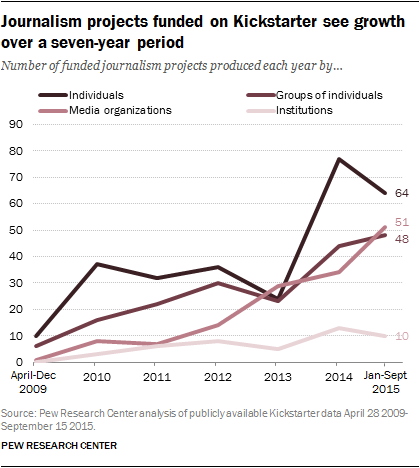
The total number of projects funded grew tenfold over time, from a total of just 17 that received full funding in 2009 to 173 in 2015. With the exception of 2013, single individuals held the greatest share of total projects, ranging from 30% to 59%, while institutions held fairly steady at between 5% and 9% over time. Groups of individuals did not show much fluctuation in their share of total projects, remaining in the 25-35% range in all years. Media organizations ranged between a low of 6% of all projects in 2009 and a high of 36% in 2013.
Sustained and longer-form journalism stand out in funded projects
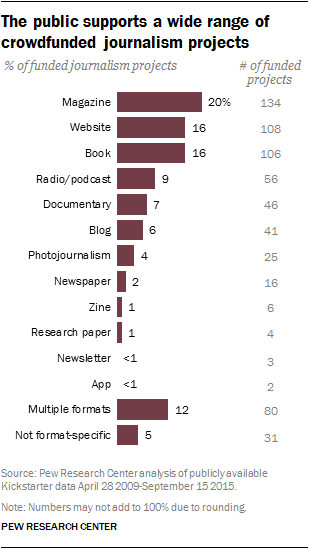
Another way to think about these funded projects is according to the format or structure of the journalism being produced. Researchers found a total of 14 different media formats represented in the journalism projects. The most common ones tend to be larger and longer enterprises that would not be possible without the support of independent donors. Among this array of formats, magazine-related projects – including the launch of new full-fledged publications, the expansion of issue-based coverage by a news magazine and standalone articles that the producers planned to pitch to existing magazines or journals – topped the list as the single most popular format, making up 20% of all funded projects in the Journalism category.
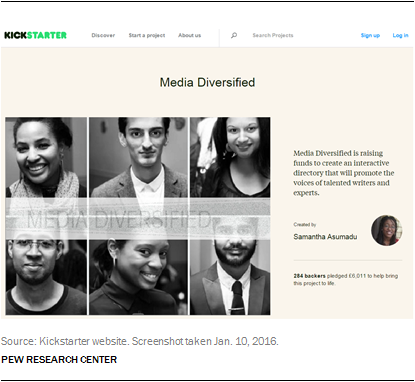
Website-related endeavors were another popular area, accounting for 16% of all funded proposals. Most of these efforts sought funds to support the online creation of news and information content, such as Media Diversified’s goal of producing an interactive directory of ethnic minority voices in the UK media landscape. A proposal to establish a multimedia website, Nuba Reports, which would provide firsthand news from Southern Sudan, was also successful, as was one by a group of citizen journalists to expand the reporting reach of Russia Insider. Others, like The Nicaragua Dispatch, turned to crowdfunding as a way of maintaining or overhauling an existing website; it asked for backers to pledge toward the cost of hiring a Web developer. In this instance, The Dispatch specifically sought to remake the site into a crowdsourcing platform.
Books also accounted for 16% and encompassed an array of genres such as history, novels, personal narratives and professional sports, as well as multiple chronicles of hiking the Appalachian Trail. Also funded were several book projects from journalists seeking to synthesize (or further build upon) their experiences from months or years of reporting. For example, freelance journalist Nathan Webster, embedded with U.S. troops during the Iraq War, produced two separate books with Kickstarter support; editorial cartoonist and war correspondent Ted Rall sought funds to return to Afghanistan; and crime reporter Scott Thomas Anderson had two successful pitches based on months of work embedded with law enforcement agencies that focused on methamphetamine-driven crime and the intersection of prison culture, crime and the underfunding of mental health care.
Storytelling through documentaries – primarily though not exclusively video – was the goal of 7% of the funded projects, 46 in all. These, too, often aimed at bringing together extended periods of work to tell a more complete story. A Dutch “Kidscorrespondent” who wanted to report the stories of Syrian children living in Lebanon, a freelancer seeking to expand the reach of his documentary about sex trafficking of minors in the U.S., and a feature-length project to tell the story of four Afghan photojournalists all found financial backing via Kickstarter. Less weighty topics also garnered support, such as a piece about the 2014 World Laser Tag Championship and films about a group of friends hiking the John Muir Trail and the 60th anniversary of Godzilla.
A total of 56 projects (9% of all proposals) were related to radio and podcasts, though podcasts clearly dominated, with 42 out of the 56 projects. Funded podcast proposals ranged from PRI Soundworks seeking funding to launch the second season of “One With Farai,” to the producers of a podcast about women’s soccer who wanted to improve and expand their content; and from the hosts of “The World’s Only Barbecue Podcast Hosted in a Car” requesting funds for hosting fees as well as gas, to the hosts of a biweekly show telling the stories of parklands and historic sites throughout the U.S. Among the non-podcast radio projects were requests for funds to help keep the nonprofit Alaska Teen Media Institute afloat, to build a new low-power FM radio station in Chicago and to expand an existing smaller-scale project in the UK into a new community radio station.
Forty-one blog projects were proposed, accounting for 6% of all proposals. Most were from individuals, such as a food and travel writer who wanted to expand his blog about working at an orchard or a seasoned, published journalist who sought funds to travel to Cuba and write about the change occurring there for his blog. But media organizations were also present – PolitiFact looked for backers of its idea to provide instant fact-checking of President Obama’s 2015 State of the Union address and the Republican response via live blog.
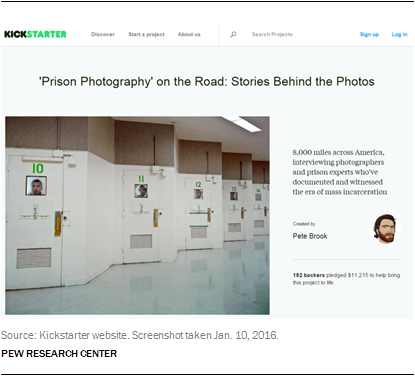
Funded proposals also included 25 photojournalism projects (4% of all examined projects), and here, too, most were put forward by single individuals such as a freelance photojournalist who wanted to travel to Poland and learn about the lives of people who live in the vicinity of Auschwitz; a photojournalism expedition to follow the proposed route of Nicaragua’s Grand Canal project; and a freelance writer who proposed traveling across America to interview photographers who focused their work on prisons and the criminal justice system.
Far less common – each representing 2% or less of all funded journalism projects (31 in all) – were newspapers, newsletters, zines, research papers and apps. Among the small handful of funded zines (usually self-published, original works intended for small circulation) was one that looked at worker’s collectives in the Twin Cities. Newspaper projects included one from the nonprofit Knoxville History Project seeking funds for the launch of a for-profit independent weekly newspaper, the Knoxville Mercury, and a relaunch of a community newspaper, The Betsie Current. An iPhone app examined the Armenian Genocide of 1915.
Not all of the projects examined, however, focused on only one medium. Eighty projects – 12% of the total – were explicitly multimedia in nature. In one such project, a journalist proposed to follow a Libyan-born man back to Libya and chronicle his efforts to help rebuild that war-torn country, producing reports in multiple media formats, including print, online blog, audio slideshow, photos and video. Another multimedia proposal was from a two-person team that intended to travel across America, interview people who had lost their jobs in the economic downturn and produce a book length oral history accompanied by a film.
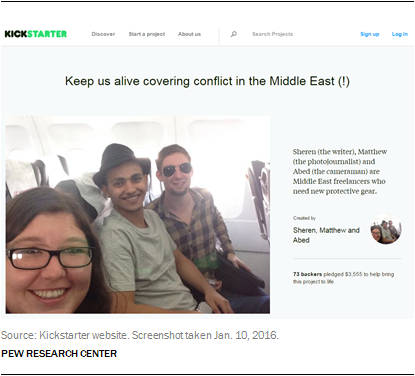
Finally, about 5% of the projects overall were for something other than a published product of some kind. This group included things as diverse as book tours, internships or experiential travel, training events, curriculum development, a translation project, and projects seeking funds to pay for protective gear (bullet-proof vests and helmets) for journalists working in conflict zones.
Across these categories, one feature that stands out – and goes against much of today’s focus on second-by-second news updates – is longer-form journalism, which tends to also take a broader, more in-depth look at news events. Magazine-related work, books and documentaries together accounted for 43% of projects funded by the public. And several other categories such as radio/podcasts, zines and blogs may have long-form, analytical elements as well.
Producers varied in the types of projects they tended to put forward. Single individuals were more likely than other types of producers to seek funding for books, which accounted for 26% of individuals’ projects compared with 12% or less for other types of producers. Media organizations, on the other hand, were the most likely to receive funding for website-related products (which made up 29% of their projects, vs. 15% or less for other producers) and radio/podcasts (17% vs. 6% or less for others).
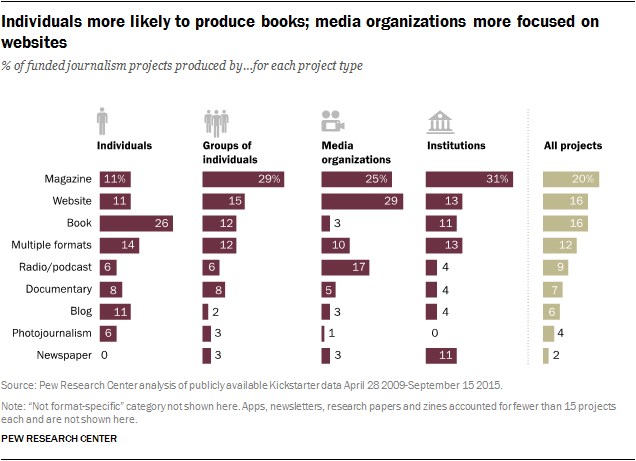
Roughly a third of journalism projects were focused outside the U.S.
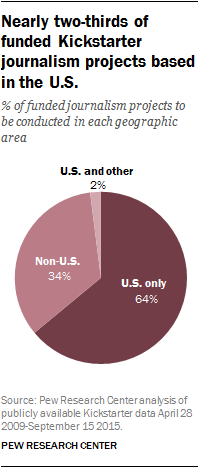
Though Kickstarter is a U.S.-based website, it allows residents from 18 different countries5 to propose projects (16 countries in North America and Europe, plus Australia and New Zealand) – and, indeed, 16% of funded projects received their funds in currencies other than U.S. dollars. Nevertheless, 64% of the funded Kickstarter journalism proposals were for projects to be conducted within the borders of the United States, while 34% were to be conducted in foreign countries. Only a small percentage of proposals (2%) were for projects that explicitly were to be carried out in both the U.S. and one or more other countries.
The foreign-based projects touched all seven continents – at least 64 countries in all, from Tonga to Iraq and from Cuba to South Africa as well as the Palestinian Territories. Beyond the U.S., the UK had the greatest number of projects at 53, followed by Canada at 22. Other countries had somewhere between one and seven projects.
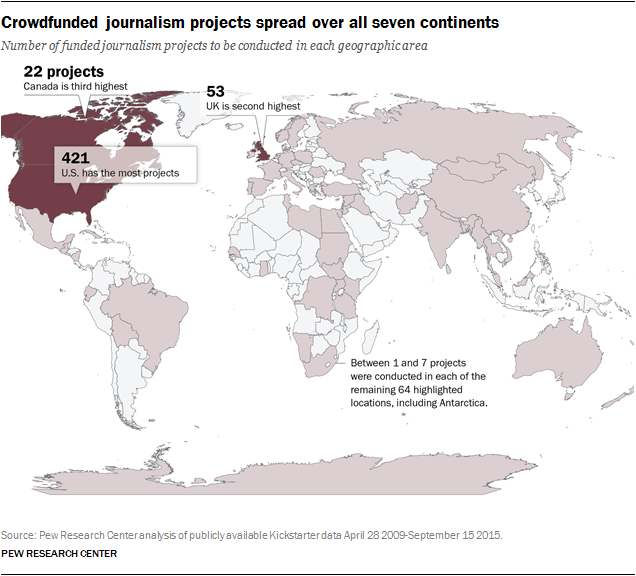
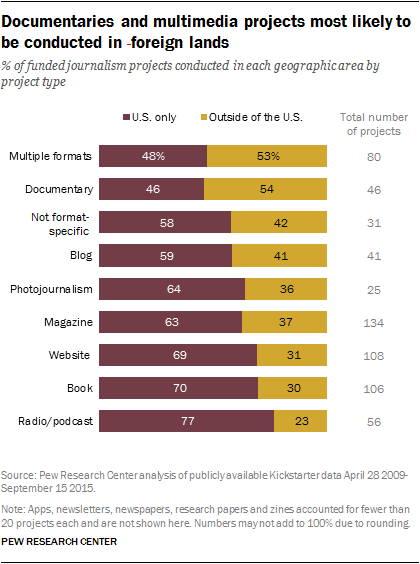
Among the types of journalism projects produced, documentaries and multimedia works were the most likely to have a non-U.S. focus, with roughly an even split between foreign and domestic. For all the others, though, U.S.-based projects were the majority, with audio works and books the most tilted toward U.S. – 77% and 70% respectively.
Travel is an integral feature of many journalism projects
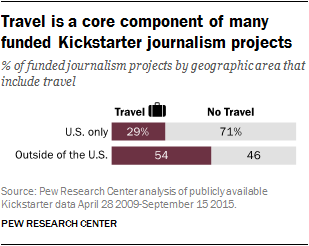
Pew Research Center also studied the project narratives (both text and video) for evidence indicating that travel was an integral feature of the proposal. If a project was described as being geographically based in one city or one metropolitan area or region, researchers concluded that travel was not likely to be fundamental to the project. However, if the description specifically mentioned multiple locations, or traveling through different states or to different countries, travel was considered to be integral to the project. Using these criteria, travel was a core component of 38% of funded journalism projects overall.
Foreign projects were more likely to include travel than were domestic ones: Fully 54% of non-U.S./international projects included travel, compared with 29% of domestic ones.6
Single individuals who produced projects were more likely than other groups to include travel as a part of a proposal – 47% of these projects, compared with just over one-third of projects from small groups of individuals (34%) and institutions (36%), and about a quarter (24%) of those from media outlets or organizations.
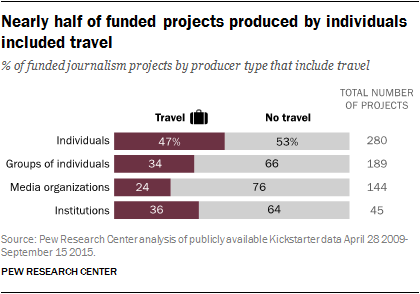
In many instances, the proposal narratives indicated that the funds requested were largely (if not exclusively) to cover travel expenses such as airfare, gas or hotels. For example, a Jewish educator proposing to host small, interfaith gatherings sought “funding to cover the costs of airfare, car rental and food,” while two friends seeking to blog about their drive from the U.S. to the southern end of Chile needed funds for a cargo boat to transport them and their truck over a roadless part of their journey. The journalism school of Stony Brook University successfully turned to Kickstarter for funds to send 16 student journalists to Kenya, as did TucsonSentinel.com in their project to send a team of photographers, editors, reporters and coders to document the complexity of the Arizona-Mexico border.
Journalism projects attracted nearly $6.3 million in backing
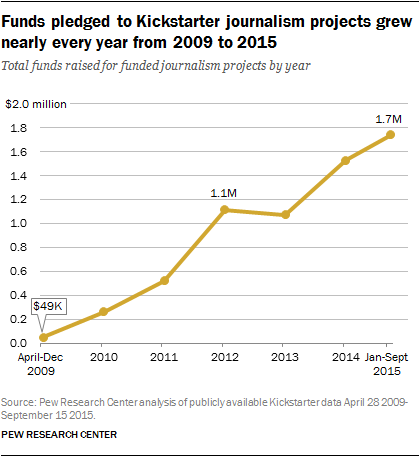
In all, the 658 funded journalism projects garnered a total of almost $6.3 million in backing. With one exception in 2013, funding grew year over year, with 52% of this – nearly $3.3 million – raised within the past two years, 2014 and 2015.
This $6.3 million over the six and a half years exceeded the total funding requested for these projects ($4,907,136) by almost $1.4 million dollars. The amounts asked for varied greatly, from a low of $1 for a project to provide online reviews of shows, restaurants and entertainment in Las Vegas to a high of $100,000 for the proposal from Civil Eats.7
The majority of projects, 66%, raised just a small amount over their original ask – up to 124% of their goal, suggesting that the extra dollars were spread out fairly evenly. Eight projects attracted in excess of 500% of what was initially requested, with six of those having initial funding goals of $600 or less.
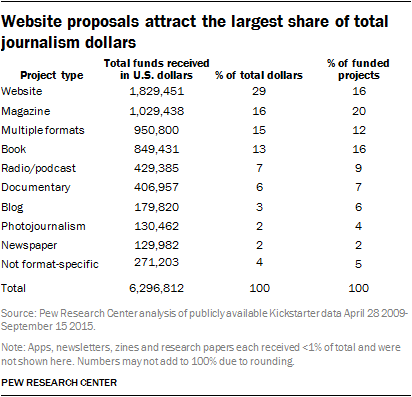
Overall, website-based projects attracted by far the largest share of revenue, $1,829,451 or 29% of the total. That substantially exceeds the 16% of all projects they accounted for, meaning they made up fewer projects but tended to have a higher price tag.
The next most lucrative project categories were magazine projects ($1,029,438, or 16% of total), multimedia projects ($950,800, or 15%) and book projects ($849,431, or 13%); these categories’ shares of funding dollars were more in line with the share of projects they accounted for (20%, 12% and 16%, respectively).
The journalism projects also displayed a wide variation in the total number of backers they attracted – from one to 3,116, with a median number of 54. The median dollar amount per project was $3,711.8
There are again differences by project type, but as indicated in the graphic below, the general trend of more backers equaling a greater total dollar amount holds true. The magazine-related category, for example, had a median number of 55 backers and $3,498 dollars raised per project, while multimedia projects saw a median of 67 backers and $5,126. The website category, though it did not have the largest number of projects overall, attracted both the largest median number of backers (94) and dollars ($6,028).
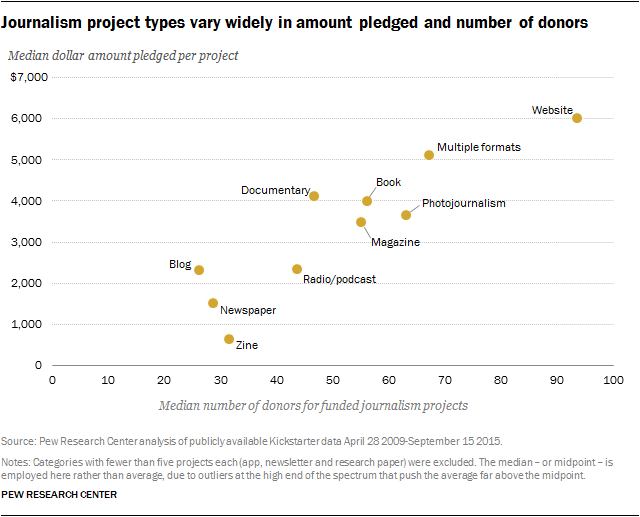
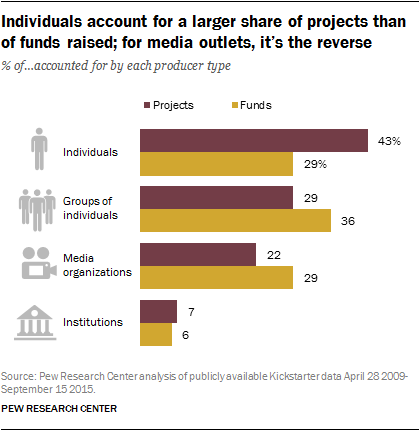
Looking at the share of total funding flowing to various types of producers, projects from small groups of individuals attracted the largest share (36%), slightly outpacing the 29% of projects they account for. Single individuals’ projects, on the other hand, brought in a far smaller share of funds (29%) than of projects (43%), while media organizations were more on par – 29% of total funds compared with 22% of projects.
Kickstarter journalism projects feature both startups and expansions
Pew Research Center studied the descriptions of the individual projects to determine if they were wholly new endeavors, or if the projects were more accurately described as some kind of expansion of an existing project. A project was considered an expansion of something that already existed only if the narrative or video specifically pointed to a verifiable entity or work which related directly to the proposal at hand. For example, a book-related project about protests in Wisconsin that sought funds to provide copies of the already-written book to a number of state senators was clearly an expansion. A proposal to launch The Breeze, a free publication to be produced by the youth of Central Vermont, on the other hand, was a startup.
Using these criteria, the Center found that these funded projects were almost evenly split between startups and expansions (51% vs. 49% respectively). But there were notable (if perhaps unsurprising) differences between who tended to request funding for a startup versus who sought funds for an expansion of a project that was already underway.
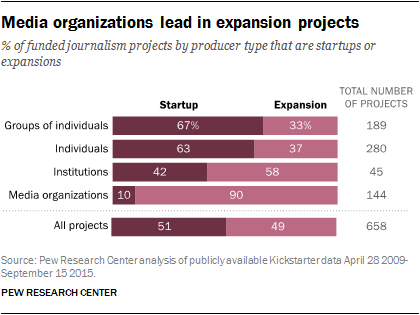
Media organizations focused much more heavily on expanding existing efforts (90% of projects). For example, The Vancouver Observer sought to expand its coverage of energy issues with the Tar Sands Reporting Project, and the International Policy Digest turned to crowdfunding to help increase interactive features on the home page as well as to initiate a partnership agreement with Agence France Press. Individuals and groups or collectives, however, were nearly twice as likely to seek funds for startup projects as for existing ones: 63% of individual projects and 67% of those from groups. For example, prior to the 2012 presidential election, a journalist launched a project to travel through U.S. swing states, talking to residents about their views in order to post them on his website; and a small team sought funds to launch Gummie, the first urban magazine in Johannesburg, South Africa. Institution-based journalism projects were the most balanced, with 42% startups and 58% expansion. Startup efforts included one from a Canadian school looking for funds to send a student to an event to write a blog post and another from a charter school raising funds for a yearbook for middle-schoolers; expansion projects, meanwhile, included an upgrade from newsprint to glossy paper for a commencement magazine, as well as a request for funds to offset a shortfall in campus funds for a student publication.
Journalism projects are a small piece of the crowdfunding pie
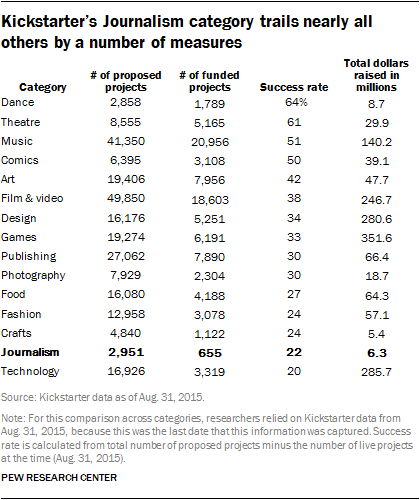
Even as the Journalism category on Kickstarter has grown, it remains one of the smallest of the other 14 categories on a number of levels. To compare the various funding categories on Kickstarter, researchers needed to rely on data through Aug. 31, 2015 (rather than Sept. 15 as the rest of the report does), because this was the last day that data across all categories were captured.
Over this time period, the number of proposed journalism projects over the seven-year time frame lagged behind every category but Dance, which saw just slightly fewer proposals (2,858). And Music and Film & Video both outpace it grandly, with more than 40,000 proposed projects each. However, Dance saw the highest rate of successful funding – 64% of all projects compared with Journalism’s 22%. Here, though, Journalism is more on par with a number of other categories including Fashion, Technology and Crafts. And in raw dollars, Journalism is again near the bottom, accumulating a mere sliver compared with the over $350 million that went to Games, roughly $250 million to Film & Video and$140 million to Music. Dance-related efforts, on the other hand, were close to Journalism at $8.6 million.




